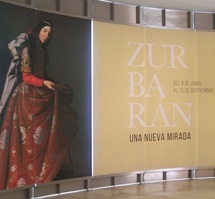
Francisco de Zurbarán has been described as the most Spanish of all Spanish painters, which perhaps is reason enough to visit the Thyssen Museum’s new summer exhibition in Madrid.
However, I have to admit that when I was invited last week to produce the English-language version of a promotional video for Zurbarán: a new perspective, I was not entirely convinced. I knew that the 17th century master had painted more than his fair share of devotional works and I was expecting a battery of down-trodden nuns, austere clergymen and gory crucifixions.
However, I have to admit that when I was invited last week to produce the English-language version of a promotional video for Zurbarán: a new perspective, I was not entirely convinced. I knew that the 17th century master had painted more than his fair share of devotional works and I was expecting a battery of down-trodden nuns, austere clergymen and gory crucifixions.

In fact, I couldn’t have been more wrong. The 63 paintings displayed against a luminous ochre background, reminiscent of the Seville where Zurbarán lived most of his life, are stunning.
A contemporary and friend of Diego Velázquez, his subtle synthesis between mysticism and realism is as metaphysical as it is religious.
A contemporary and friend of Diego Velázquez, his subtle synthesis between mysticism and realism is as metaphysical as it is religious.

“Zurbarán is not simply a painter of monks and saints”, says the exhibition’s lead curator Odile Delenda. “He’s much more varied, a great colourist, a painter of enormous imagination, continually working on new compositions and subject matter”.
The French academic, who is perhaps the world’s leading expert on Zurarbán, is equally as convinced of his relevance to the later cubist and surrealist art movements.
The French academic, who is perhaps the world’s leading expert on Zurarbán, is equally as convinced of his relevance to the later cubist and surrealist art movements.

Certainly, Zurbarán’s geometrical, hard-edged forms and large, plain areas of paint in works like “Saint Francis contemplating a skull” make it easy to understand why Juan Gris was once described as “the Zurbarán of the twentieth century”. And when it comes to Zurbarán’s masterful still lifes, Odile Delenda even detects an influence on Salvador Dalí.
The exhibition’s title also refers to new discoveries about the Sevillian master since Madrid’s last major show of his work at the Prado Museum 28 years ago. Indeed, eight of the twelve canvasses newly attributed to Zurbarán since then are on display at the Thyssen.
As I hope the video below illustrates, Zurbarán’s mastery of line, the silent peace suffusing his paintings, and his prodigious talent as a colourist make him one of the seventeenth century masters closest to our modern sensibility. (Video production by Reportarte)
Zurbarán: a new perspective is open from 9 June until the 13 September at the Thyssen Museum in Madrid and more information can be found on the museum’s English language website.
The exhibition’s title also refers to new discoveries about the Sevillian master since Madrid’s last major show of his work at the Prado Museum 28 years ago. Indeed, eight of the twelve canvasses newly attributed to Zurbarán since then are on display at the Thyssen.
As I hope the video below illustrates, Zurbarán’s mastery of line, the silent peace suffusing his paintings, and his prodigious talent as a colourist make him one of the seventeenth century masters closest to our modern sensibility. (Video production by Reportarte)
Zurbarán: a new perspective is open from 9 June until the 13 September at the Thyssen Museum in Madrid and more information can be found on the museum’s English language website.

 Canal RSS
Canal RSS
